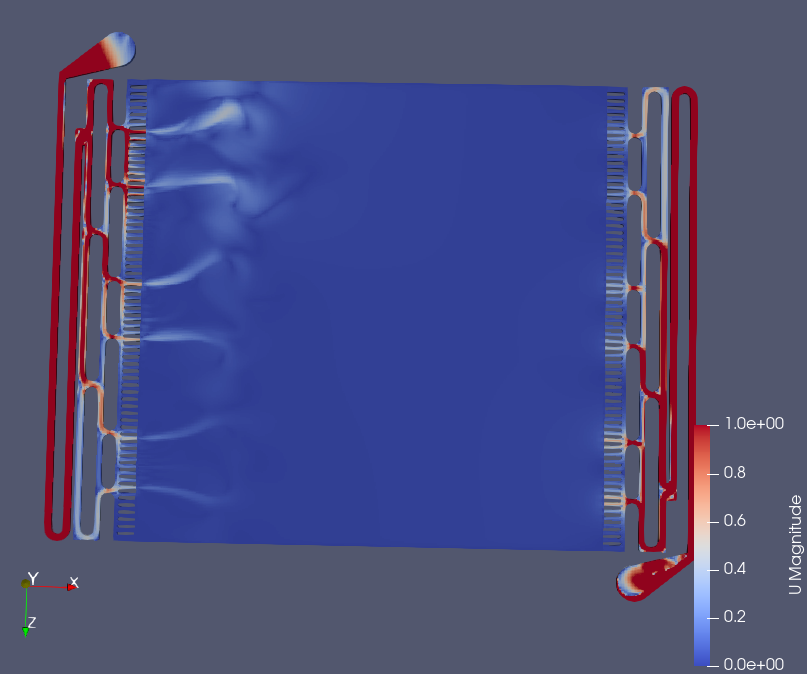Designing the large-format cell
-
For the "large-format" cell, we'd like to target as large of a geometric area as possible, and ideally have the flow frame be useable both for single-cell and stack testing. This means it needs to possess adequate internal fluid manifolds and flow diffuser/spreading geometry. We must also consider shunt currents once we progress to stack testing, so we'd like to design the cell with that issue in mind upfront.
We plan to start with a flow-through design, as it is much, much simpler to design and manufacture than flow field-based approaches.
This thesis has some helpful figures - I haven't read it yet myself, but it looks quite useful. The author is now a professor at University of Padua.
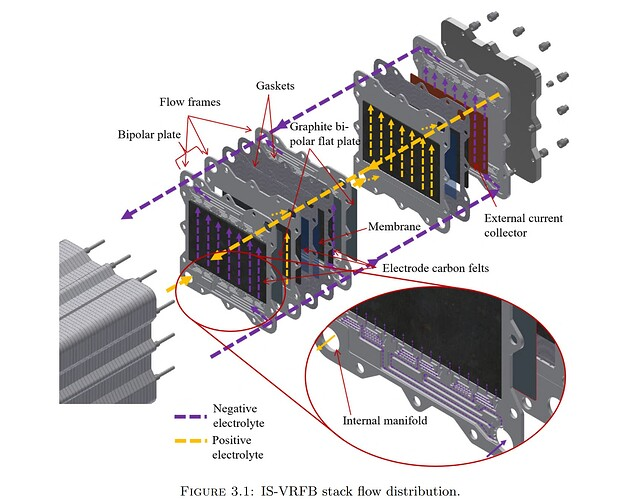
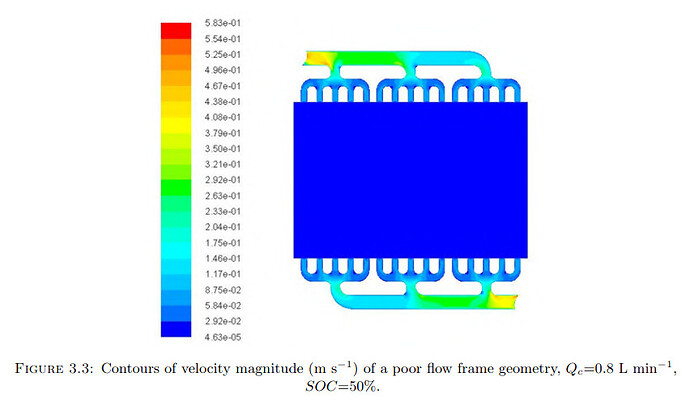
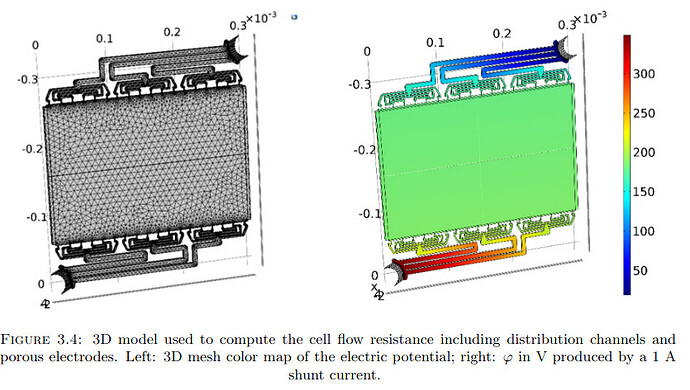
Basically we want to make our own version of this. Ideally we could prototype it with polypropylene FDM printing... but in any real application it would be injection molded.
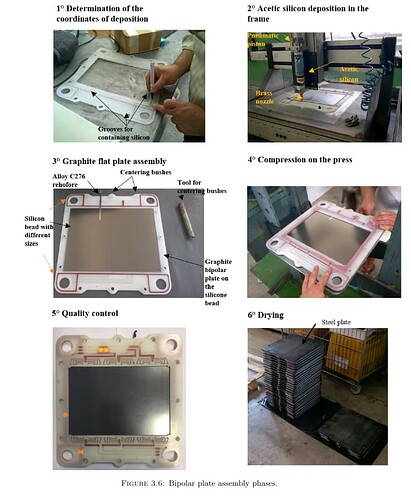
A good image showing the path of a shunt current, which leads to a drop in energy efficiency as well as uneven current distribution (and possibly plating, for hybrid RFBs):
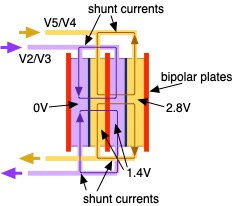
Image from University of Padua researchers: https://iopscience.iop.org/article/10.1149/MA2024-0217mtgabs
Right now, we need a flow frame that:
- Has the correct geometry for flow-through graphite felt electrodes (and possibly polymer felts/spacers, for hybrid chemistries)
- Doesn't leak
- Distributes flow evenly through the felts
- Offers adequate pressure drop and shunt currents when implemented in a stack
References
PhD thesis: https://www.research.unipd.it/handle/11577/3422708
Optimization paper: https://doi.org/10.1016/j.electacta.2021.139667
Flow field optimization paper (we don't have flow fields, but the simulation framework/procedure is interesting): https://linkinghub.elsevier.com/retrieve/pii/S0378775321009563
-
-
I saw the blog post which also mentioned the problems of 3d printing the panels of that size without warping. I did a quick google on injection molding and that could also get $$$ and a bit beyond some DIYers with the need for pressure.
But what about casting? Are there resin based or other low temp materials that could be cast? Because making the mold would be easy. A dummy part could be printed from any material and it could be made in, say forths that could be glued together. And for the mold there is a quick setting plaster like material we use in construction for repairs (one brand is "Quickfix) that dries to a porcelain like material, very hard, and very fast. It's sold with set times in minutes. Make your dummy part and put it on some wax paper or plastic wrap on a flat surface with a frame around the part. fill with plaster and when cured, spray with a sealer that wont react to the resin to seal the micro pores. Then with it flipped over and the dummy back in, and the frame around it, pour the other half. You have a simple and cheap to make mold for casting.
-
From the way I looked at the plate, it has open channels that become enclosed when placed against the next plate.
I've never done any 3d printing, but from what I read, they don't do overhangs well because the hot plastic would not have any support under it and adding supports in the channels would restrict flow.
-
@wordmark@mas.to said in Designing the large-format cell:
Previous thought: so u say this cell makes O2 and H2 going out from separate outlets?
No, that is not at all the intended operation, but it is a possible unintended side reaction if something goes wrong or is poorly designed/outside the operating mode.
@wordmark@mas.to said in Designing the large-format cell:
What volts amps will your stack require? Production costs per stack?
@wordmark@mas.to said in Designing the large-format cell:
what are the properties for such a battery? (How does it compare to a 48V 14kWh #LiFePo4? (Which can burn down houses if cells are not high quality)
We are very far from having a datasheet on such an RFB, as we are still very much in the R&D phase, but there are some datasheets out there from commercial companies which could give you an idea, but generally RFBs don't make sense below 10 kWh in size because of their size and requirement of centrifugal pumps.
We have a FAQ that might answer some of your questions here.
-
Any particular reason why you don't consider milling or laser cutting? FDM printing large surfaces that need to stay flat seems to be a challenge on general. Have you envisioned printing the structure (manifold?) on a prefabricated sheed of plastic?
@sepi said in Designing the large-format cell:
Any particular reason why you don't consider milling or laser cutting? FDM printing large surfaces that need to stay flat seems to be a challenge on general. Have you envisioned printing the structure (manifold?) on a prefabricated sheed of plastic?
I have considered this, and I'm not against it, I am just pursuing FDM first until I can prove that we need to try something else. With our current approach it's desirable for sealing purposes to have a flat, sealed top surface on the flow frame, ie overhanging geometry, so laser/milling are out, unless you try to bond a layer on top, and it starts to get complicated. Milling plastic, especially fine details, is also hard to do well for amateur machinists - it tends to just melt unless you have your speeds and feeds totally dialed + flood coolant. We hope to have an FDM printable design to allow as many others to get in on this, since FDM printers are much more abundant and easy to use than capable plastic CNC mill setups.
Printing on plastic sounds kind of hard, especially for PP filaments, and it doesn't get rid of the overhanging geometry question.
@sepi said in Designing the large-format cell:
Also did you ever consider TPU for the parts in contact with the electrodes? It's pretty resistant to chemicals and ribbery and could thus male seals.
We haven't tried TPU yet, if I recall @danielfp248 saw somewhere that it wouldn't be compatible with the zinc-iodide chemistry that has been our main workhorse - specifically the charged triiodide species, which is really a pain in terms of chemical resistance. We'd need to confirm that it's resistant to triiodide. You're right that it's flexibility could help make it a good seal though.
@sepi said in Designing the large-format cell:
I guess that both injection molding and casting don't allow for fancy internal geomtries needed for the manifolds.
Both injection molding and casting can do internal geometries, but as @Vorg pointed out it's cost prohibitive on small-scales.
@Vorg said in Designing the large-format cell:
I've never done any 3d printing, but from what I read, they don't do overhangs well because the hot plastic would not have any support under it and adding supports in the channels would restrict flow.
FDM printing can "bridge" to some extent, which we are exploiting to print our prototype flow frames here. @danielfp248 made a great post showing some of his efforts to print it here, I highly recommend you check that post out - we're definitely making progress with this approach! Eventually, if we got a really great flow frame design that was locked-in, it may make sense to make a lot of them with injection molding.
-
@wordmark@mas.to said in Designing the large-format cell:
Previous thought: so u say this cell makes O2 and H2 going out from separate outlets?
No, that is not at all the intended operation, but it is a possible unintended side reaction if something goes wrong or is poorly designed/outside the operating mode.
@wordmark@mas.to said in Designing the large-format cell:
What volts amps will your stack require? Production costs per stack?
@wordmark@mas.to said in Designing the large-format cell:
what are the properties for such a battery? (How does it compare to a 48V 14kWh #LiFePo4? (Which can burn down houses if cells are not high quality)
We are very far from having a datasheet on such an RFB, as we are still very much in the R&D phase, but there are some datasheets out there from commercial companies which could give you an idea, but generally RFBs don't make sense below 10 kWh in size because of their size and requirement of centrifugal pumps.
We have a FAQ that might answer some of your questions here.
@kirk thanks keep me updated
-
@wordmark@mas.to said in Designing the large-format cell:
Previous thought: so u say this cell makes O2 and H2 going out from separate outlets?
No, that is not at all the intended operation, but it is a possible unintended side reaction if something goes wrong or is poorly designed/outside the operating mode.
@wordmark@mas.to said in Designing the large-format cell:
What volts amps will your stack require? Production costs per stack?
@wordmark@mas.to said in Designing the large-format cell:
what are the properties for such a battery? (How does it compare to a 48V 14kWh #LiFePo4? (Which can burn down houses if cells are not high quality)
We are very far from having a datasheet on such an RFB, as we are still very much in the R&D phase, but there are some datasheets out there from commercial companies which could give you an idea, but generally RFBs don't make sense below 10 kWh in size because of their size and requirement of centrifugal pumps.
We have a FAQ that might answer some of your questions here.
-
Would spraying a solvent diluted silicone caulking form a electrolyte resistant gasket surface?
Edit; this was after reading on the Cricut cut silicone sheet. After reading on the electrolyte a bit more, it seems not even silicone is a good gasket material for I3- ???
-
Would spraying a solvent diluted silicone caulking form a electrolyte resistant gasket surface?
Edit; this was after reading on the Cricut cut silicone sheet. After reading on the electrolyte a bit more, it seems not even silicone is a good gasket material for I3- ???
@DDM I don't know if this would work. We can try it! The problem would be spreading this evenly enough and making sure it cures properly. While silicone doesn't work well if it is constantly getting put under pressure (like in a peristaltic pump), it does fine as gasketing material. Note that it's not like the material "fails" it just leaks I2 through time because of diffusion, this diffusion also makes the gaskets warp a bit.
-
@DDM I don't know if this would work. We can try it! The problem would be spreading this evenly enough and making sure it cures properly. While silicone doesn't work well if it is constantly getting put under pressure (like in a peristaltic pump), it does fine as gasketing material. Note that it's not like the material "fails" it just leaks I2 through time because of diffusion, this diffusion also makes the gaskets warp a bit.
@danielfp248 The evenness of the coating could be achieved by setting up a parameter controlled spraying process, which is not really hard to do and can utilize cheap tools (HVLP spray gun and such).
Alternatively I can see silicone dipping working as well, but that would require some tooling.
I've got experience in developing equipment for commercial application of such silicone coatings, and I think I could add some more consulting/value in this project. Is there a way to have direct contact, I tried finding email addresses on chemisting.com but failed, luckily I found the forum. If this turns out well, I might equip a large yacht with this DIY technology as the main energy storage system, including for it's hybrid diesel/electric propulsion. -
@danielfp248 The evenness of the coating could be achieved by setting up a parameter controlled spraying process, which is not really hard to do and can utilize cheap tools (HVLP spray gun and such).
Alternatively I can see silicone dipping working as well, but that would require some tooling.
I've got experience in developing equipment for commercial application of such silicone coatings, and I think I could add some more consulting/value in this project. Is there a way to have direct contact, I tried finding email addresses on chemisting.com but failed, luckily I found the forum. If this turns out well, I might equip a large yacht with this DIY technology as the main energy storage system, including for it's hybrid diesel/electric propulsion.@DDM Sounds very interesting, if you can give it a try let us know if it works well! A potential problem I see is also the wetting of polypropylene, I don't know how well these silicones wet it, polypropylene is notoriously hard to glue or apply stuff to.
-
There is flame activation, and even a combination that deposits silicone oxides: https://www.bohle.com/bx-NL/Pyrosil-Professionele-set/BO5209491
But I'm not sure if that is even needed; the layer will stay stuck for (careful) assembly and perform the sealing duty as it is clamped. Serviceability will be zero, after disassembly the old coating will probably be worthless and a new coating should be applied.
I don't have the materials and setup currently to perform tests.Is there a way to discuss some things directly without filling this forum with a slow-chat?
-
@Vorg First we will make sure the design doesn't leak with current silicone gaskets. Once we have that I can send you a message and we can talk a bit more about how it would work with a silicone sealant.
-
@Vorg First we will make sure the design doesn't leak with current silicone gaskets. Once we have that I can send you a message and we can talk a bit more about how it would work with a silicone sealant.
@danielfp248 yes, except vorg is another user

-
@danielfp248 yes, except vorg is another user

@DDM Lol, sorry, I will message you both.

